
Johann Weikhard Freiherr von Valvasor or Johann Weichard Freiherr von Valvasor or simply Valvasor was a natural historian and polymath from Carniola, present-day Slovenia, and a fellow of the Royal Society in London.

Ravne Castle is a castle near the town of Ravne na Koroškem, in the Carinthia region of northern Slovenia.
Janez is a Slovene form of the given name John.

St. James's Parish Church is a church in Ljubljana, the capital of Slovenia. It is dedicated to St. James the Greater. Its name is often incorrectly translated as St. Jacob's because Slovene, like many other languages, uses the same word for both James and Jacob.

Turjak Castle is a 13th-century castle located above the settlement of Turjak, part of the municipality of Velike Lašče in the Lower Carniola region of Slovenia. The castle is 20 km southeast of Ljubljana and is considered among the most impressive in the area.

Snežnik Castle is a 13th-century castle located in the southwest part of the Lož Valley near the settlement of Kozarišče in the municipality of Loška Dolina, Slovenia. Its name is coincidentally identical to a univerbation based on the Slovene word sneg 'snow', but is actually a Slovenized form of the name of the noble house of Schneberg, whose possession it initially was. The Schnebergs were followed by the houses of Lamberg, Eggenberg, Lichtenberg, and Schönburg-Waldenburg.
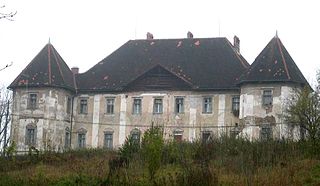
Bokalce Castle is a castle or mansion in Ljubljana, the capital of Slovenia.
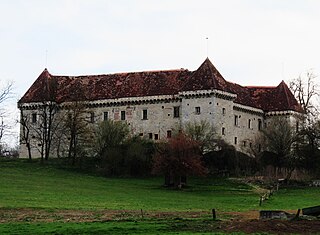
Krumperk Castle is a castle or manor located in Gorjuša near the town of Domžale in central Slovenia.

Kalec Castle is a partially ruined castle in Bač in Slovenia.

Jablje Castle, also known as Jable Castle, Habah Castle, or Habach Castle, is a castle above the settlement of Loka pri Mengšu, Slovenia. It is located on the western edge of the Mengeš Plain.
Izlake is a settlement in the Municipality of Zagorje ob Savi in the Central Sava Valley, central Slovenia. The area is part of the traditional region of Upper Carniola. It is now included with the rest of the municipality in the Central Sava Statistical Region.

Bogenšperk Castle is a 16th-century castle located in the Municipality of Šmartno pri Litiji in central Slovenia. It is best known for its association with the 17th-century scientist and natural historian Johann Weikhard von Valvasor, a fellow of the Royal Society in London.
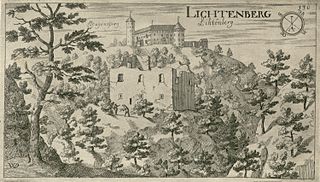
Lihtenberk Castle is a 13th-century castle ruin located in the Municipality of Šmartno pri Litiji in central Slovenia, directly adjacent to the later Bogenšperk Castle. It is best known for a minor association with the 17th-century historian Johann Weikhard von Valvasor, who owned the ruin and styled himself "von Lichtenberg."

Leskovec Castle or Turn Castle is a 15th-century castle north of the village of Leskovec pri Krškem, southeastern Slovenia. It has been redesigned in the 16th and the 18th centuries.
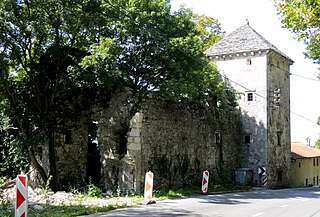
Trilek Castle, also known as Old Castle, is a small castle or fort in the settlement of Col, in the Municipality of Ajdovščina in southwest Slovenia. Built in the early 16th century, it was first mentioned in the 17th-century historian Johann Weikhard von Valvasor's 1689 survey The Glory of the Duchy of Carniola.

Lož Castle, also known as Pusti Grad, is a castle ruin above the settlement of Lož in central Slovenia's Lož Valley. The castle and its lordship are mentioned in period documents under various names, including Los, Louse, Lose, and Lösch.
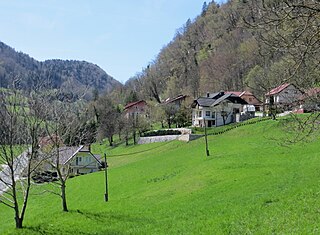
Podlipovica is a settlement immediately west of Izlake in the Municipality of Zagorje ob Savi in central Slovenia. The area is part of the traditional region of Upper Carniola. It is now included with the rest of the municipality in the Central Sava Statistical Region.

The Volčji Potok Arboretum was opened to the public in 1952. It originally formed part of the Souvan family estate in 1885, which was taken over by the University of Ljubljana in 1952 and legally declared a place of cultural and natural heritage of national importance. Now independent of the university, it is the most visited botanical garden in Slovenia and in recent years has become well known for its spring flower shows. The arboretum is primarily a botanical garden for woody plants, the only one in Slovenia.
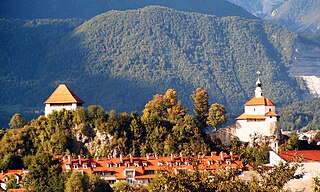
Little Castle in Kamnik, Slovenia, once formed part of a castle constructed in the 11th or early 12th century at the strategic site above the narrow passage near an important trail. The Romanesque chapel of St. Eligius is one of the most important Slovene medieval monuments, despite later alterations, and is one of the oldest of its kind in Europe. The chapel features a wooden ceiling and exquisite fresco paintings. Kamnik's Medieval Days festival takes place at the foot of the castle every June.
Vrtača pri Semiču is a former settlement in the Municipality of Semič in southern Slovenia. The area is part of the traditional region of Lower Carniola and is now included in the Southeast Slovenia Statistical Region. Its territory is now part of the town of Semič.





















